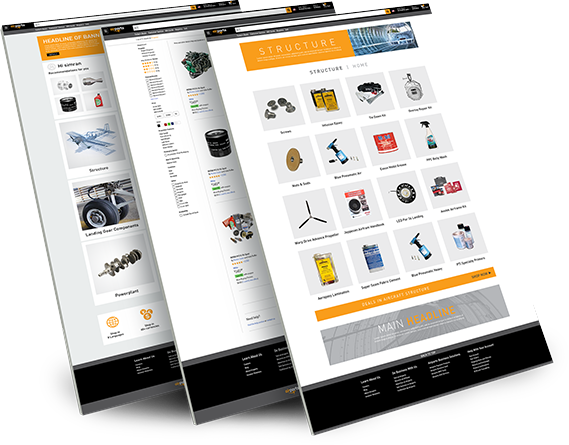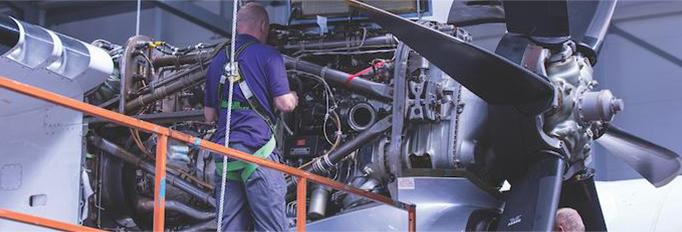GAIN ACCESS TO
NEW CUSTOMERS
Aircraft owners, licensed mechanics, repair stations, maintenance departments, enthusiasts, they all need parts and they all have parts to sell. AirParts enables the sales over over 50,000 unique parts to thousands of buyers.

BEGIN YOUR JOURNEY WITH AIRPARTS AERO: MARKET YOUR AIRCRAFT PARTS AND SERVICES
Whether you're a newcomer to the aviation marketplace, an established parts or maintenance enterprise, an aircraft owner with surplus components, or a service provider aiming to expand, AirParts is your trusted partner. Here's your step-by-step guide to launching your sales journey with AirParts.

YOUR ROADMAP TO BECOMMING AN AIRPARTS AERO SELLER

SELECT THE AIRPARTS AERO SELLER PACKAGE THAT SUITS YOU BEST
AirParts provides a range of tailored plans to fit the unique needs of every seller:
Individual Non-Commercial Plan:
- Cost: No monthly fee.
- Selling Fee: $1.00 per item sold.
- Best For: Individuals who anticipate selling fewer than 25 items monthly.
AirParts Commercial Plan:
- Cost: $29.95/month.
- Selling Fee: None, regardless of the number of items sold.
- Features: Unlimited monthly sales without per-item selling fees. Ideal for regular sellers and businesses.
AirParts OEM Plan:
- Cost: $99.00/month.
- Special Features: Enhanced services and dedicated support tailored for manufacturers or PMAs.
- Best For: Manufacturers and PMAs seeking a partnership advantage.
In addition to the above, AirParts applies a referral fee for every sale. This fee is determined as a percentage of the total transaction and fluctuates based on the product category. For a detailed view of our selling fees, please refer to our pricing breakdown page.
REGISTER TO BECOME AN AIRPARTS AERO SELLER
Kickstart your journey in the aviation marketplace by setting up your AirParts Aero Seller Account today. Join the AirParts Aero community and elevate your sales potential!
SETTING UP YOUR AIRPARTS SELLER ACCOUNT: WHAT YOU'LL NEED
Whether you're already a part of the AirParts family as a buyer or a newcomer looking to sell, getting your seller account up and running is straightforward. Here’s a checklist to ensure a smooth setup:
- Existing Account or Business Email: Use your current AirParts buyer account or register with a business email address.
- Credit Card: Have it on hand for any potential charges or verifications.
- Government-Issued Identification: This is a security measure we employ to safeguard both our buyers and sellers.
- FAA Credentials: If applicable, make sure you have these ready.
- Special Certifications: For those registering as a Part 145 repair station, PMA, OEM, Part 91 or 135 flight department, or maintenance facility, a copy of your FAA Air Carrier license is essential.
- Tax Information: Your taxpayer identification number or EIN will be necessary.
- Contact Details: A valid business phone number.
- Bank Details: Ensure you have the relevant banking information where AirParts can deposit your sales proceeds.
With these details in hand, you’re all set to embark on your selling journey with AirParts.
EXPAND YOUR HORIZON WITH AIRPARTS AERO: WHAT CAN YOU OFFER?
AirParts is a dedicated platform for the aviation community, designed to cater to a broad spectrum of aviation-related products and services. Here's a glimpse of what you can showcase:
- Aircraft Parts: From engines, avionics, and landing gear to smaller components, if it's aircraft-related, it has a home here.
- Maintenance Services: Offer your specialized repair, overhaul, or routine maintenance services.
- Pilot Supplies: This can include items like headsets, flight bags, charts, and other essentials.
- Aircraft Tools: High-quality tools specific to aircraft repair and maintenance.
- Aviation Apparel: From pilot jackets to crew uniforms.
- Ground Support Equipment: Everything needed for ground operations, from tow bars to refueling equipment.
- Aircraft Interiors: Sell seats, cabin fittings, lighting, and other interior components.
- Aerospace Materials: Raw materials used in aircraft manufacturing or repair.
- Aviation Electronics & Instruments: Avionics, GPS systems, communication devices, and more.
- Training Materials: Flight training manuals, simulator software, educational kits, and other resources.
Keep in mind, the integrity of the aviation industry is paramount. Ensure that all products and services listed adhere to the necessary regulations, certifications, and quality standards set by aviation authorities, guaranteeing safety and reliability to your buyers.
LIST YOUR PRODUCTS ON AIRPARTS: A SIMPLE GUIDE
Are you eager to showcase your products on AirParts? The process is straightforward, but certain criteria determine what you can offer on our platform. Here's a comprehensive breakdown:
1. Product Eligibility Criteria:
- Category: Some product categories are open to all, while others may need a commercial or OEM seller account.
- Brand & Authorization: If you're selling a product that requires brand-specific authorization (like avionics from Brand X), you'd need to present the respective authorization documents.
- Seller Plans: Some items might necessitate a specific seller plan, be it commercial or OEM.
2. The AirParts Product Category Table:
Refer to our table to understand the various product categories, sample products within them, permissible conditions, and any restrictions. To dive deeper into product limitations and how to request authorization for a restricted product, our guidelines are your go-to resource. If you're planning on utilizing our fulfillment service, make sure to explore the 'Fulfillment by AirParts' item and category restrictions. This feature will be available post-January 11 within your account management pages.
3. Product Listing Steps:
- Login: Access your seller account.
- Navigate to Dashboard: Once logged in, you'll find yourself on the Seller Dashboard.
- Listing Creation: Using the Seller Portal, craft your product listing. If you have a vast inventory, an API for bulk upload is also available.
- Link to Existing Listings: With our master catalog-based system, it's easy to associate your products with pre-existing listings on AirParts.
4. Product Identification:
All products are systematically categorized using unique identifiers:
- MPN (Manufacturer Part Number)
- GTIN (Global Trade Item Number)
- NSN (National Stock Number)
- EAN (European Article Number)
- ISBN (International Standard Book Number)
- UPC (Universal Product Code)
You can quickly identify and list a part using any of these numbers. AirParts also generates an exclusive AirParts Stock Identification Number tailored to the MPN, NSN, or ISBN you provide.
Note for Manufacturers: If you're the original manufacturer, ensure that your product has a unique UPC code issued by GS1. If this isn't available, an exemption request will be necessary.
With these guidelines at your fingertips, showcasing your products on AirParts becomes a breeze. Here's to fruitful sales and a thriving business on our platform!
PREPARING YOUR PRODUCTS FOR LISTING ON AIRPARTS: A CHECKLIST
- Before diving into the listing process on AirParts, ensure you have all the necessary product details at your fingertips. Here's a step-by-step guide to help you get organized:
Identification Numbers:
- Familiarize yourself with your product's unique identifiers, such as:
- MPN (Manufacturer Part Number)
- GTIN (Global Trade Item Number)
- NSN (National Stock Number)
- EAN (European Article Number)
- ISBN (International Standard Book Number)
- UPC (Universal Product Code)
- Familiarize yourself with your product's unique identifiers, such as:
Inventory Details:
- Ascertain how many units of the product you have in stock.
Product Condition:
- Review the product's condition against the approved list available here. Make sure you align your product's state accordingly.
Shipping Specifications:
- Understand and document the shipping weight of the item.
- Note down the dimensions of the box or packaging.
- Be clear on the shipping options you'll offer, whether it's expedited, international, or standard.
Product Specifics:
- If the product's image isn't available in the master category data store, ensure you have high-quality images ready.
- Details like color, size, material, and other specifications should be at hand.
Optimization for Search:
- List relevant keywords and search terms that buyers might use to find your product. This boosts your product's visibility on AirParts' search engines.

Most of the time, the AirParts platform already hosts listings for commonly sold aviation items. However, for unique or newer parts, you might need to create a new product listing. Here’s a step-by-step breakdown:
1. Using Existing Product Listings:
- Search for the Product: Begin by searching for the product using its MPN, GTIN, NSN, EAN, ISBN, or UPC on AirParts.
- Add Your Inventory: If you find the product listing, proceed by adding the quantity you have in stock.
- Specify Product Condition: Define the condition of each item based on the approved list of conditions. It ensures buyers know exactly what they're getting.
- Set Your Price: Determine a competitive price based on the market and your evaluation.
- Activate Your Listing: Once all the details are added, make the listing live so potential buyers can view and purchase.
2. Creating a New Product Listing:
- Search First: Before creating a new listing, make sure you’ve thoroughly searched the platform to ensure the product doesn't already exist.
- Product Details: Enter all necessary details like the MPN, GTIN, product condition, shipping specifications, and any other relevant details.
- Upload High-Quality Images: Provide clear photos from multiple angles, showcasing the product. It builds trust with potential buyers.
- Optimize for Search: Input relevant keywords and search terms to enhance product visibility on the platform.
- Review & Submit: Double-check all the details for accuracy, then submit the new product listing.
- Wait for Approval: Depending on AirParts’ policy, there might be a review process before your new listing goes live.
By ensuring your listings, whether existing or new, are comprehensive, clear, and accurate, you significantly enhance your chances of successful sales on AirParts. Happy selling!
UNDERSTANDING THE PRODUCT
DETAIL PAGE

The Product Detail Page (PDP) on AirParts is the cornerstone of a product's online presence on the platform. It's where potential buyers gain an in-depth understanding of an item, learn about its specifics, view its images, and make the decision to purchase. Let's dive deeper into the elements that make up this page:
1. Title:
- Limited to 190 characters.
- Typically styled with the first letter of every word capitalized.
- Should be concise, clear, and accurately represent the product.
2. Product Images:
- Ensure images are of high quality and resolution, ideally not exceeding 1,500 pixels per image.
- Images should showcase the product from various angles, highlighting important details.
3. Variations:
- Represents different product conditions.
- Useful for products that come in varying states or grades, allowing potential buyers to select their preferred version.
4. Product Description:
- This section provides a detailed overview of the product.
- Use descriptive sentences that are easy to understand and provide valuable information about the product.
- Utilize bullet points for key benefits, features, or technical specifications, making the information digestible and scannable.
5. Key Seller – Featured Seller Box:
- The prime real estate of the detail page, this section offers sellers unparalleled visibility.
- This position primarily serves commercial and OEM seller accounts, promoting their offers for maximized conversion potential.
- An advanced algorithm ensures a fair distribution of this prime spot among sellers, taking into account various factors like seller performance, price, shipping speed, and more.
- From this box, buyers can quickly 'Buy Now' or add the product to their cart.
6. Other Sellers:
- If an offer doesn't land in the Featured Seller Box, it's listed in this section.
- Each offer has a 'BUY NOW' button, granting buyers the flexibility to choose from various sellers based on their preference of price, seller rating, or other criteria.
For sellers, understanding the layout and functionalities of the PDP is crucial. It's where your product's impression is made, and mastering its nuances can significantly boost your sales conversion on AirParts. Whether you're a non-commercial seller or a high-volume OEM, ensuring your product details are accurate, engaging, and optimized will help drive success on the platform.
THE IMPORTANCE OF FAST FULFILLMENT IN BOOSTING SALES SUCCESS
In today's fast-paced e-commerce environment, customers have grown accustomed to quick, reliable service. The speed of order fulfillment can significantly impact a seller's reputation, customer satisfaction, and, ultimately, sales figures. Here's why fulfillment speed is so integral to e-commerce success:
1. Meeting Customer Expectations:
- Modern consumers expect rapid delivery. Websites like Amazon with their Prime service have set a high standard. Quick fulfillment meets this expectation and can enhance customer satisfaction.
2. Competitive Advantage:
- Faster shipping can set you apart from competitors. Even if two sellers offer the same product at a similar price, a buyer is more likely to choose the one that can deliver faster.
3. Increase in Sales:
- Quick fulfillment can lead to higher sales conversion rates. A promise of fast shipping can be the deciding factor for many online shoppers.
4. Positive Reviews & Feedback:
- On-time or earlier-than-expected deliveries often lead to positive reviews. Such feedback boosts a seller's reputation and can drive more sales in the long run.
5. Lowered Cart Abandonment:
- Slow shipping estimates at the checkout stage can deter customers. By ensuring speedy fulfillment, you can decrease cart abandonment rates.
6. Enhanced Customer Loyalty:
- When customers know they can rely on you for quick deliveries, they're more likely to return for future purchases, fostering loyalty.
7. Reduced Inventory Costs:
- Fast turnover of stock through quick sales can lead to reduced storage costs and better inventory management.
8. Mitigating Issues:
- Quick fulfillment leaves a buffer. If there's an issue with the first shipment, sellers have more time to rectify the problem without significantly delaying the customer's expected delivery date.
9. Opportunity for Premium Services:
- Sellers can offer premium, expedited shipping options at an additional cost, creating another revenue stream.
10. Building Trust:
- Demonstrating reliability through prompt fulfillment builds trust. Customers feel more confident purchasing from sellers they deem trustworthy.
In conclusion, in the realm of e-commerce, time is indeed of the essence. Investing in efficient and speedy fulfillment processes not only enhances the customer experience but also directly impacts a seller's bottom line. As the saying goes, "Time is money," and in the world of online sales, fast fulfillment can be the key to unlocking substantial revenue growth.
Learn more about Fulfillment by AirParts Aero and other shipping options
GUIDE TO EFFECTIVE PRODUCT PRICING IN OUR COMPETITIVE INDUSTRY
In a market driven predominantly by price, especially for commodity sales, it's paramount for sellers to find that perfect balance between attracting buyers and maintaining profitability. Setting the right price isn't just about undercutting competitors; it's about understanding all the costs involved and then making an informed decision. Here's a breakdown of how to consider the components mentioned:
1. Item’s Acquisition Cost:
- Direct Cost: This is the primary amount you pay to acquire or manufacture the item.
- Associated Costs: Include costs like customs duties, transportation, or any taxes paid during the acquisition.
2. AirParts Referral Fees:
- These fees are the charges that AirParts Aero will take per sale.
- It’s essential to know the exact percentage or flat fee for each item category.
3. Shipping and Fulfillment Costs:
- Shipping Costs: Consider both domestic and international shipping fees, which can vary widely.
- Packaging: The cost of boxes, bubble wrap, or any other packaging materials.
- Handling Costs: This might include labor or storage fees associated with preparing products for shipment.
4. Overhead and After Sales Support Costs:
- Fixed Overheads: These are costs that don't change regardless of how much you sell, such as rent, salaries, or utilities.
- Variable Overheads: These change based on the volume of sales, such as commission for sales staff or credit card transaction fees.
- After Sales Support: Costs like return handling, customer service support, warranty claims, etc. Good after-sales support can enhance customer loyalty, but it's essential to factor in its costs.
5. Profit Margin:
While covering costs is fundamental, businesses aim for profit. Decide on a target profit margin for your items. This percentage is what you’d ideally add on top of all your costs to determine the final price.
Steps to Set the Right Price:
- Calculate Total Costs: Sum up all the costs mentioned above for a particular item.
- Determine Desired Profit: Add your target profit margin to these costs.
- Research the Market: Know the competitive price range for similar products.
- Adjust for Perceived Value: If your product offers added value over competitors (e.g., superior quality, brand reputation), you might be able to price higher.
- Regularly Review & Adjust: Monitor sales, feedback, and competitors to adjust prices as needed.
Final Note: While competitive pricing is crucial, it's essential not to compromise on quality or service. In the long run, a business's reputation, product quality, and customer service play equally pivotal roles in ensuring sustained success, especially in markets saturated with similar products. Remember, it's not always the cheapest product that wins, but the best value for the price.
UNDERSTANDING AND LEVERAGING BUYER REVIEWS

Building a successful trust-enabled marketplace requires a keen focus on transparency in both transaction processes and product quality. Here's a more detailed breakdown of how this can be achieved and why it's crucial for platforms like AirParts:
Importance of Reviews: Reviews serve multiple purposes. They allow potential buyers to gauge the credibility and reliability of a seller. Positive reviews act as a vote of confidence, while negative reviews highlight areas of improvement. By encouraging buyers to leave honest feedback, sellers can continuously improve and adapt their services.
Building Trust Through Issue Resolution: Not every transaction will be perfect. Issues can arise, ranging from product quality to shipping delays. The key is how sellers handle these problems. Proactively reaching out to address and resolve any issues demonstrates a commitment to customer satisfaction. By taking the time to engage with buyers and understand their concerns, sellers establish a foundation of trust.
High Standards Lead to Credibility: Setting and maintaining high standards for sellers is paramount. The air parts industry, given its regulatory nature and the critical importance of the parts, requires stringent quality controls. By setting high expectations, AirParts ensures that buyers can confidently purchase knowing that the products meet the necessary standards.
Customer Satisfaction Guarantee: Offering guarantees or assurances further instills confidence in buyers. Knowing that their purchase is protected provides an added layer of security, making them more inclined to complete a transaction.
Incredible Buying Experience: The end-to-end buying experience matters. This doesn’t just encompass the product's quality, but also factors like ease of navigation on the platform, clarity of product descriptions, prompt customer support, and seamless payment processes. Prioritizing these elements ensures that buyers have a positive experience from browsing to post-purchase.
To sum up, trust is an integral component of any marketplace, especially in sectors where the stakes are high, such as the air parts industry. AirParts, by emphasizing transparency, customer engagement, and a commitment to quality, positions itself as a reliable and reputable platform. Continuous efforts to uphold and enhance these values will undoubtedly solidify its place in the market and foster lasting relationships with both buyers and sellers.





